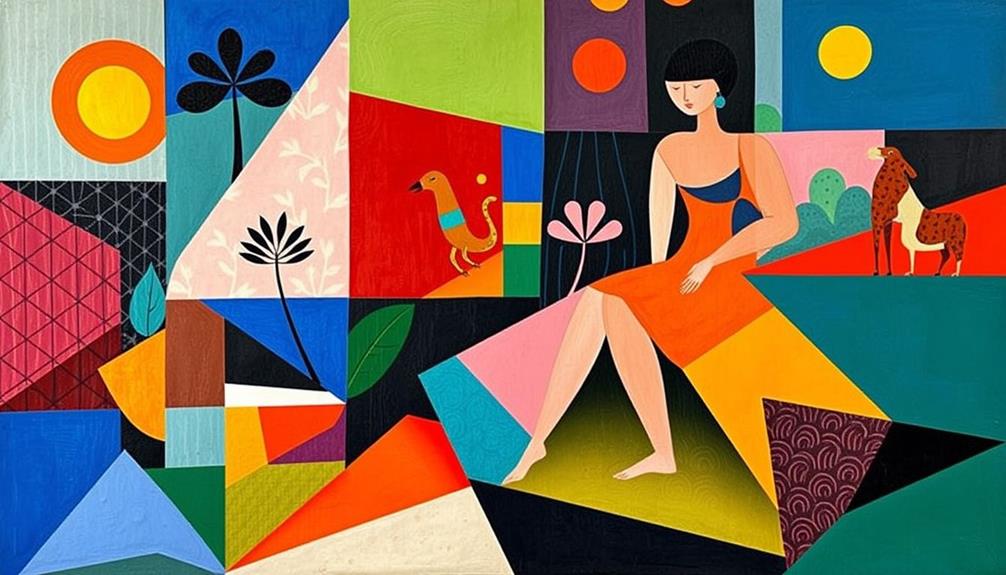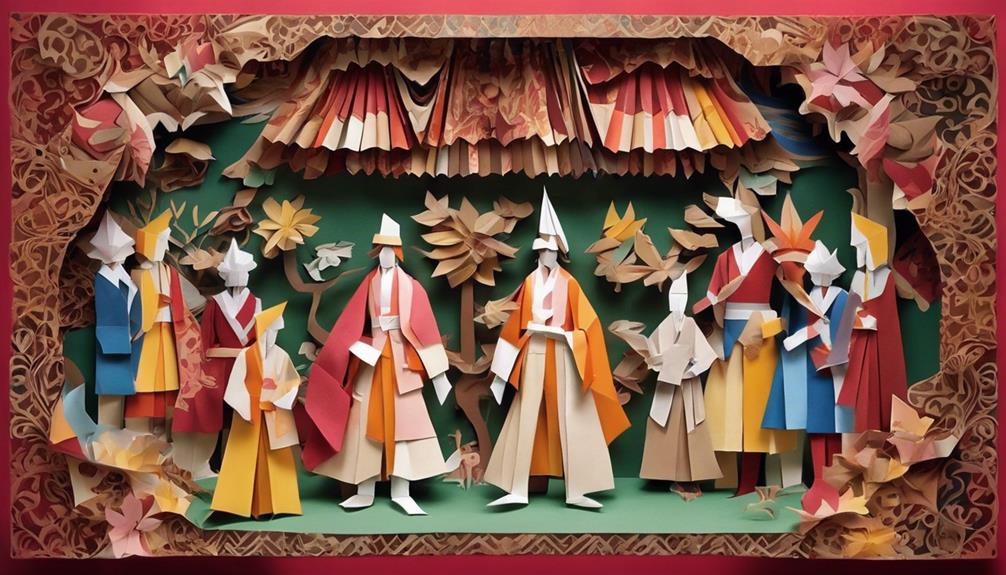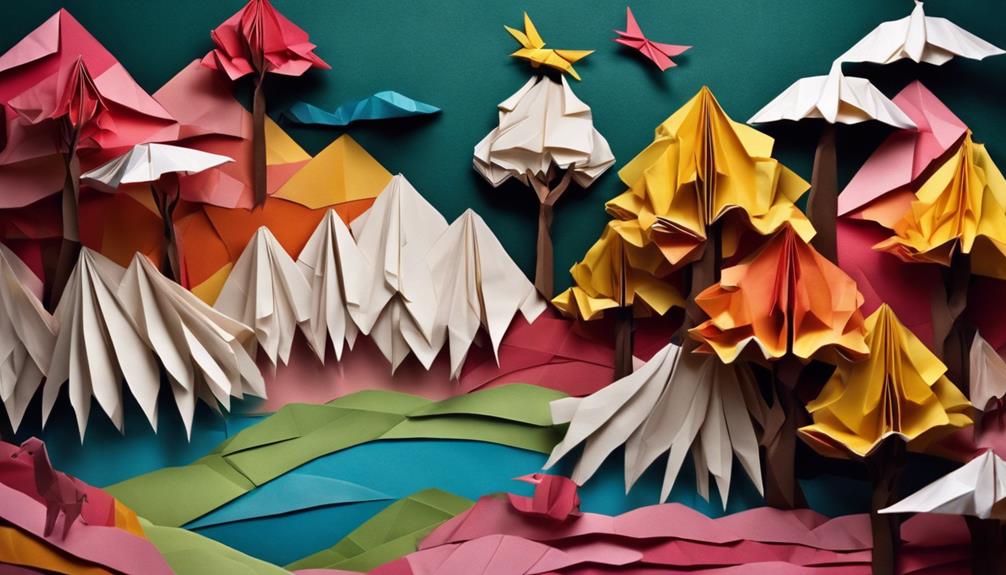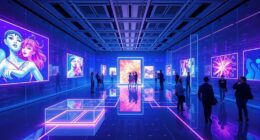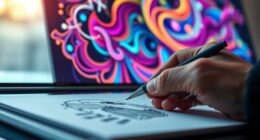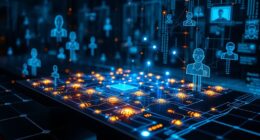When you explore the Kalighat painting tradition, you're witnessing a vibrant fusion of history and modernity. Originating near the Kalighat Temple in 19th century Kolkata, these artworks initially depicted religious themes but evolved to address societal issues with bold colors and expressive techniques. You'll see strong female figures and social commentary intertwined with everyday life. Today, contemporary artists innovate while honoring traditional methods, expanding the art into textiles and decor. This living tradition reflects Bengali culture and its transformations. There's much more to uncover about Kalighat's journey through time and its impact on today's art scene.
Key Takeaways
- Kalighat painting originated in 19th-century Kolkata, adapting to market demands while reflecting the cultural identity and societal transformations of Bengal.
- The art form evolves from religious themes to social commentary, addressing contemporary issues and critiquing societal norms through vibrant narratives.
- Traditional techniques utilize natural pigments and materials, showcasing the craftsmanship and authenticity rooted in the cultural heritage of Kalighat.
- Modern adaptations incorporate current themes and multimedia, expanding the art's relevance while preserving historical techniques through educational initiatives.
- Visitors can engage with Kalighat art at the Kalighat Temple, galleries, and workshops, experiencing both traditional and contemporary interpretations firsthand.
Origins of Kalighat Painting
Kalighat painting emerged in the early 19th century in Kolkata, India, as a vibrant response to the influx of tourists and pilgrims visiting the Kalighat Temple. This art form was primarily created by patuas, specialized artists who traditionally painted scrolls. As the number of visitors to the temple grew, these artists adapted their work, producing unique paintings that captured the attention of travelers.
These adaptations reflect not only the changing demands of the market but also a rich engagement with the local culture, akin to how artists today explore diverse platforms to share their work and connect with audiences reviving old friendships.
Kalighat paintings reflect a blend of traditional Indian art and local folk styles, using natural pigments and readily available materials. You can see how these artists skillfully translated their surroundings into vivid imagery, often incorporating elements of everyday life and the culture of Kolkata.
The emergence of this art coincided with British colonial rule, allowing artists to showcase social and cultural dynamics through satirical and contemporary themes.
Today, the Victoria and Albert Museum holds the largest collection of Kalighat paintings, preserving works that span from the 1830s to the 1930s. These paintings serve as a reflection of the creativity and adaptability of Kalighat artists, who turned a local tradition into a celebrated form of art cherished by many.
Themes and Subjects
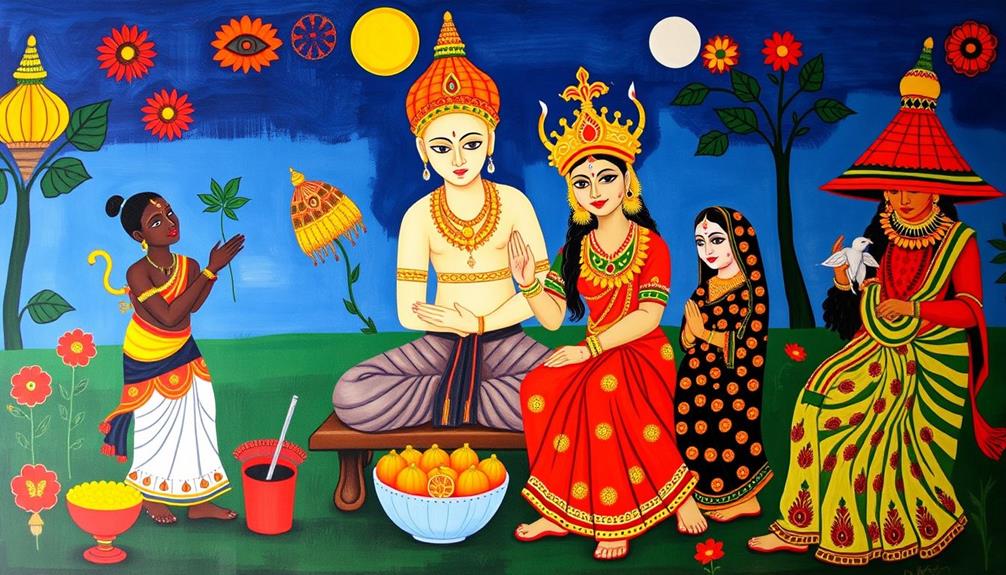
When you explore Kalighat paintings, you'll notice a fascinating mix of themes and subjects. These artworks not only showcase religious iconography and narratives but also provide sharp social commentary and celebrate everyday life.
The incorporation of cultural relevance in art forms can foster respect and understanding, much like how Aboriginal resources enhance learning experiences in early childhood education. As you look closer, you'll see how they reflect the vibrant cultural identity of Bengal and its evolving stories.
Religious Iconography and Narratives
The Kalighat painting tradition is rich in religious iconography and narratives that vividly capture Hindu mythology. You'll notice that early works primarily depicted deities and mythological stories, showcasing epic battles such as Durga vs. Mahishasura and Hanuman vs. Ravana.
As you explore deeper, you'll find an evolution in themes that reflects societal changes, including the interplay between narcissistic traits and cultural perceptions of divinity. Here are three key aspects to reflect on:
- Religious Iconography: Early paintings prominently featured figures like Kali and Ganesha, emphasizing their divine attributes and significance in Hindu culture.
- Secular Themes: Over time, artists began incorporating subjects from everyday life, making the artwork relatable and accessible to a broader audience.
- Narratives: The influence of local folklore and oral traditions enriched the narratives, intertwining mythological tales with contemporary life, enhancing the viewer's connection to the art.
These vibrant paintings utilized expressive brushwork and bold colors to convey strength and beauty, particularly in female figures.
This artistic approach not only celebrated religious themes but also mirrored the cultural perceptions of women within society, affirming the integral role of religious iconography and narratives in the Kalighat tradition.
Social Commentary and Satire
Emerging from its roots in religious iconography, the Kalighat painting tradition began to embrace social commentary and satire, reflecting the complexities of 19th-century Indian society. Artists used the Kalighat genre to critique the hypocrisy of religious figures and to address the moral decay prevalent in their communities. Notable works, such as those depicting the Tarakeshwar murder scandal, highlighted contemporary events and brought attention to the contradictions of colonial India.
This shift in artistic focus mirrors broader trends in society, as seen in the psychological impact of cultural narratives on self-perception, akin to how astrology claims to influence personality traits.
Through vibrant colors and expressive styles, these artists engaged audiences, making complex social narratives accessible. They often incorporated humor and satire, particularly in their portrayals of changing gender roles, presenting strong female figures that challenged traditional norms.
The blend of everyday life scenes with mythological themes allowed artists to merge popular culture with social commentary, showcasing the evolving dynamics of urban Bengali society.
Celebrating Everyday Life
Kalighat paintings celebrate the vibrancy of everyday life, showcasing the rich tapestry of 19th-century Kolkata. These artworks evolved from depicting Hindu deities to illustrating social dynamics, capturing the essence of daily experiences.
Through their unique narrative style, they serve as a window into the lives of ordinary people while offering sharp social commentary. Additionally, the emotional complexities found in these artworks can be likened to the intense experiences often portrayed in BPD-coded characters, highlighting struggles with identity and relationships.
You'll notice several recurring themes in Kalighat paintings:
- Changing Roles of Women: Strong female figures often reflect the shifting societal norms and the empowerment of women during this period.
- Critique of Social Norms: Many pieces highlight the hypocrisy of religious figures and societal expectations, using humor and satire to provoke thought.
- Celebration of Local Traditions: Artists portray everyday activities, local customs, and the essence of community life, making these paintings relatable and timeless.
Contemporary artists draw inspiration from these themes, revitalizing the Kalighat tradition while addressing modern issues.
Techniques and Materials
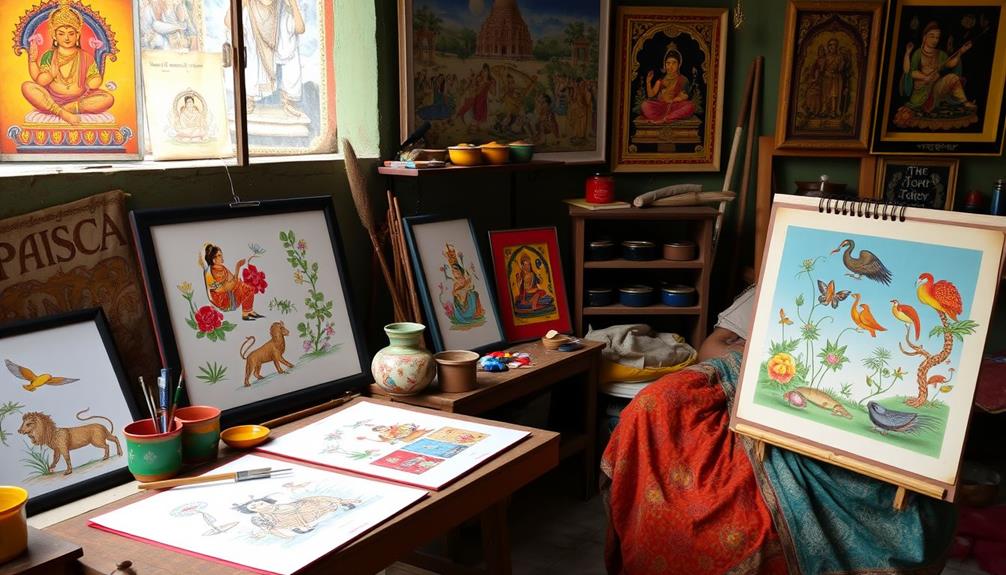
When you explore the techniques and materials of Kalighat painting, you'll find a rich tradition rooted in natural substances and homemade pigments.
Artists skillfully use squirrel hair brushes for detailing, bringing their vibrant colors to life on cloth or paper. This practice is reminiscent of how essential oils, derived from natural sources, can enhance wellness in various forms; for instance, essential oils for hair growth promote healthier locks.
As you consider modern adaptations, you'll see how these time-honored methods continue to evolve while maintaining their expressive essence.
Traditional Painting Materials
Utilizing natural sources for pigments, the Kalighat painting tradition showcases a rich palette that reflects its cultural roots. The artisans create homemade pigments from various natural materials, enhancing the authenticity and vibrancy of their work.
For instance, turmeric produces a bright yellow, while the Aparajita flower yields a stunning blue. This connection to nature is a reflection of their craftsmanship, similar to how vegan food options emphasize the use of natural ingredients in their preparation.
The materials used in these paintings are essential to their character. Here are three traditional painting materials that stand out:
- Homemade Pigments: Derived from plants and minerals, these pigments guarantee a vibrant color palette.
- Squirrel Hair Brushes: Artisans utilize these brushes for precision, allowing for detailed work.
- Durable Canvas: Although cloth was once the primary canvas, the shift to paper has made these artworks more accessible.
The production process involves grinding pigments with granite mullers and mixing them with binding agents like gum from bel fruit and crushed tamarind seeds.
This not only guarantees color longevity but also enhances the depth of the vibrant watercolors applied. Together, these elements form the foundation of the Kalighat painting tradition.
Artistic Techniques Employed
Artisans in the Kalighat painting tradition employ a variety of techniques that bring their vibrant works to life. They start by sketching initial outlines in pencil, which serve as the framework for the striking compositions. After the outlines are defined, they fill these designs with vibrant colors derived from natural materials, including fresh pigments that can be compared to those used in juicing techniques for various fruits.
For instance, they grind pigments from the Aparajita flower for blue and turmeric for yellow, using binding agents like gum from bel fruit and crushed tamarind seeds to guarantee the colors adhere well.
The bold outlines created with brushes made from squirrel fur and goat tail give Kalighat paintings their signature look. This technique facilitates strong lines and dynamic movement, capturing the viewer's attention.
The artists adopt a flat, two-dimensional style, emphasizing simplicity and emotional expression. By minimizing backgrounds, they direct focus onto the subjects, enhancing their emotional depth.
Additionally, as market demand shifted, artists shifted from traditional scroll formats to single-page compositions, allowing for contemporary themes and social commentary to emerge.
The blend of traditional techniques and vibrant colors makes each Kalighat painting a unique representation of cultural narratives and artistic heritage.
Modern Adaptations and Innovations
Today, contemporary Kalighat artists frequently experiment with organic dyes and modern materials, moving away from the traditional natural pigments and homemade inks of the past. This evolution not only preserves the art form but also revitalizes it with fresh perspectives, similar to how modern farmhouse decor trends emphasize the use of natural materials and sustainable choices.
You'll notice that many modern adaptations blend traditional techniques with innovative methods, creating a unique fusion.
Here are three key aspects of this transformation:
- Contemporary Themes: Artists now incorporate social commentary and current events, making their work relevant and thought-provoking.
- Innovative Techniques: The use of digital printing and multimedia presentations alongside classic bold outlines and expressive brushwork enhances the visual impact.
- Market Presence: The revival has expanded Kalighat's reach into merchandise like textiles and home decor, appealing to a broader audience beyond traditional art collectors.
Educational initiatives and workshops further encourage this exploration of historical techniques while fostering modern interpretations.
Cultural Significance

Kalighat paintings are more than just vibrant artworks; they're a rich tapestry of Bengali culture that captures the essence of local traditions, beliefs, and societal transformations from the 19th and early 20th centuries. As you explore a collection of Kalighat paintings, you'll notice how local artists skillfully blend visual storytelling with social commentary.
Many artworks critique hypocrisy among religious figures and highlight moral decay within elite society. This critique resonates with contemporary audiences, making the paintings a powerful reflection of ongoing societal issues. Significantly, much like the evolving dynamics of celebrity relationships, these paintings encapsulate changes in societal norms and values over time.
Moreover, Kalighat paintings celebrate strong female figures and address themes of women's empowerment, contributing to essential discussions around gender roles and societal expectations. By portraying women in dynamic, assertive roles, these artworks challenge conventional views and inspire change.
Recognized by UNESCO as an important cultural heritage, Kalighat painting not only preserves Bengali traditions but also fosters cultural appreciation both locally and globally. This art form continues to engage audiences with its vibrant narratives, ensuring that the voices and stories of the past remain relevant in today's world.
Through Kalighat, you connect deeply with the cultural heritage it represents.
Historical Context

The emergence of Kalighat painting in the 19th century near the iconic Kalighat Temple in Kolkata reflects the complex socio-cultural landscape of British colonial rule. This art form developed as artisans, known as patuas, began creating paintings for pilgrims and tourists, which shifted the focus from traditional scroll narratives to single-frame artworks.
As you explore this tradition, you'll notice how it became a medium for social critiques, addressing pressing contemporary issues.
Here are three key aspects of the historical context of Kalighat painting:
- Influences from events like the Tarakeshwar murder scandal and Mahant-Elokeshi affair shaped the themes, blending religious imagery with social commentary.
- The style evolved to depict everyday life, merging local folk traditions with urban experiences that resonated with the public.
- The Victoria and Albert Museum houses the largest collection of Kalighat paintings, showcasing works from the 1830s to the 1930s, underlining its significance in documenting Bengali culture.
Kalighat painting not only reflects the artistic trends of its time but also serves as a mirror to the societal dynamics of the era.
Economic Influences

Economic dynamics played a crucial role in shaping the Kalighat painting tradition. As Kolkata emerged as an economic center in the 19th century, artisans, particularly patuas, flocked to the city to take advantage of increased market opportunities driven by tourism at the Kalighat Temple. This influx led to a surge in the production of Kalighat paintings, which became popular souvenirs for visitors.
The migration from rural areas to urban Kolkata transformed the artisan community, pushing painters to shift from traditional scroll paintings to single-frame artworks that appealed to consumer tastes. The portable nature of these paintings further expanded their market reach, attracting both local working-class buyers and foreign travelers.
However, economic fluctuations in the early 20th century greatly impacted this traditional art form. The arrival of cheaper printed reproductions and chromolithographs posed a formidable challenge, leading to a decline in demand for hand-crafted Kalighat paintings.
As artists struggled to compete with mass-produced alternatives, many sought alternative employment, resulting in a loss of this unique cultural heritage. Ultimately, the economic landscape profoundly influenced the sustainability of Kalighat painting, highlighting the fragile balance between tradition and market forces.
Contemporary Adaptations
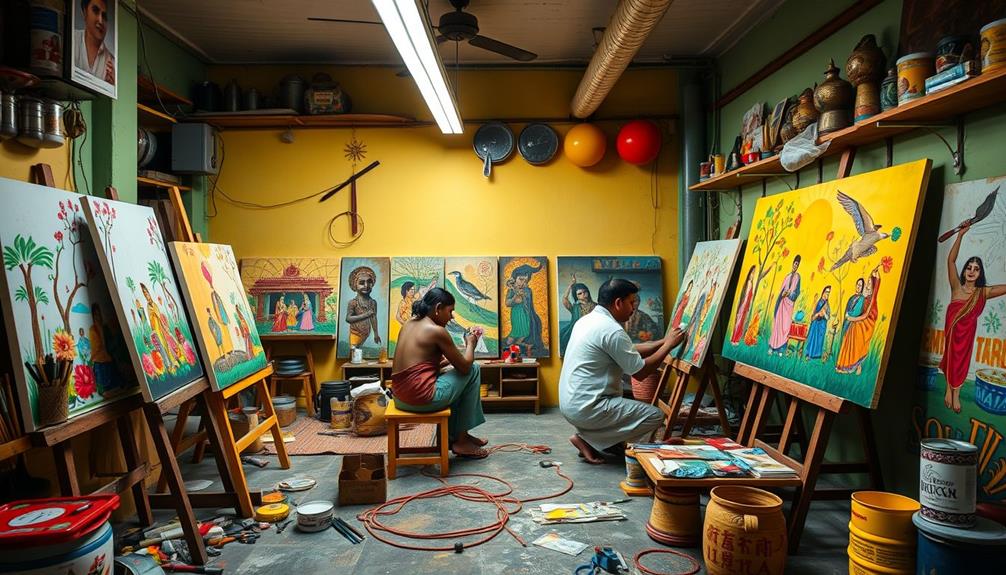
Amidst the challenges faced by Kalighat painting due to economic fluctuations, contemporary artists are breathing new life into this traditional art form. By merging traditional techniques with modern themes, they reflect current societal issues and events, making the art more relevant today.
Here are three key adaptations you should know about:
- Subject Matter: Artists are moving beyond religious motifs to explore secular subjects and pop culture references, broadening the appeal of Kalighat painting.
- Materials Used: Many have embraced organic dyes and contemporary styles, which not only honor the past but also satisfy modern aesthetic sensibilities.
- Global Reach: Kalighat paintings are gaining traction in global art markets, leading to their inclusion in textiles, home decor, and fashion, thereby reaching wider audiences.
Moreover, educational initiatives and workshops are being organized to promote awareness and appreciation of Kalighat painting. This guarantees that the tradition remains relevant in contemporary art discourse.
Exhibitions showcasing these modern interpretations are bridging the gap between traditional art forms and contemporary artistic expressions, proving that Kalighat painting continues to evolve and inspire.
Visitor Experience

Experiencing the vibrant world of Kalighat painting in Kolkata immerses you in a rich cultural tapestry. As you visit the Kalighat Temple, you connect with the origins of these beautiful artworks, setting the stage for a profound visitor experience.
Local artists often showcase their talent here, offering you a unique opportunity to engage with the very creators of Kalighat paintings.
Cultural tours frequently include stops at galleries that highlight both traditional and contemporary adaptations of this art form. You'll find that these exhibitions provide valuable insight into the evolution of Kalighat painting over the years.
Strolling through local markets, you'll be captivated by the lively atmosphere, where original Kalighat artworks await your discovery and purchase, deepening your understanding of the art's significance within the community.
Participating in workshops lets you interact directly with local artists, allowing you to learn about the traditional techniques and materials they use.
This hands-on experience fosters a deeper appreciation for the craft and its connection to Kolkata's historical and social landscape, making your time in this city truly unforgettable.
Frequently Asked Questions
What Is the History of Kalighat Paintings?
Kalighat paintings began in the early 19th century as souvenirs for temple visitors. Over time, artists adapted to market demands, addressing social issues and incorporating satire, reflecting the changing dynamics of colonial India.
What Was the New Trend Seen Within the Kalighat Artists After 19TH Century?
Like a river changing course, Kalighat artists shifted from long narrative scrolls to single-page images after the 19th century. You'll notice their work embraced secular themes, reflecting society's issues and modern artistic influences.
What Was the Process of Kalighat Painting?
You start by outlining figures in pencil, then use black ink for clarity. Next, you apply vibrant colors with natural pigments, blending shades for depth, and finish with binding agents to guarantee the colors stay vibrant.
What Was the Contribution of the Kalighat School to the Realm of Painting?
The Kalighat School's vibrant brushstrokes symbolize India's evolving identity. You see, they transformed traditional art into accessible pieces, capturing societal shifts and emotions, blending rural roots with urban life, and influencing modern Indian painting profoundly.
Conclusion
Kalighat painting, with its vibrant colors and rich history, is like a bridge connecting the past to the present. You've explored its origins, themes, and techniques, witnessing how it reflects the soul of a culture. As you appreciate its contemporary adaptations, remember each brushstroke tells a story, inviting you to dive deeper into its cultural significance. By supporting this tradition, you're not just preserving art; you're keeping the heartbeat of a community alive.


